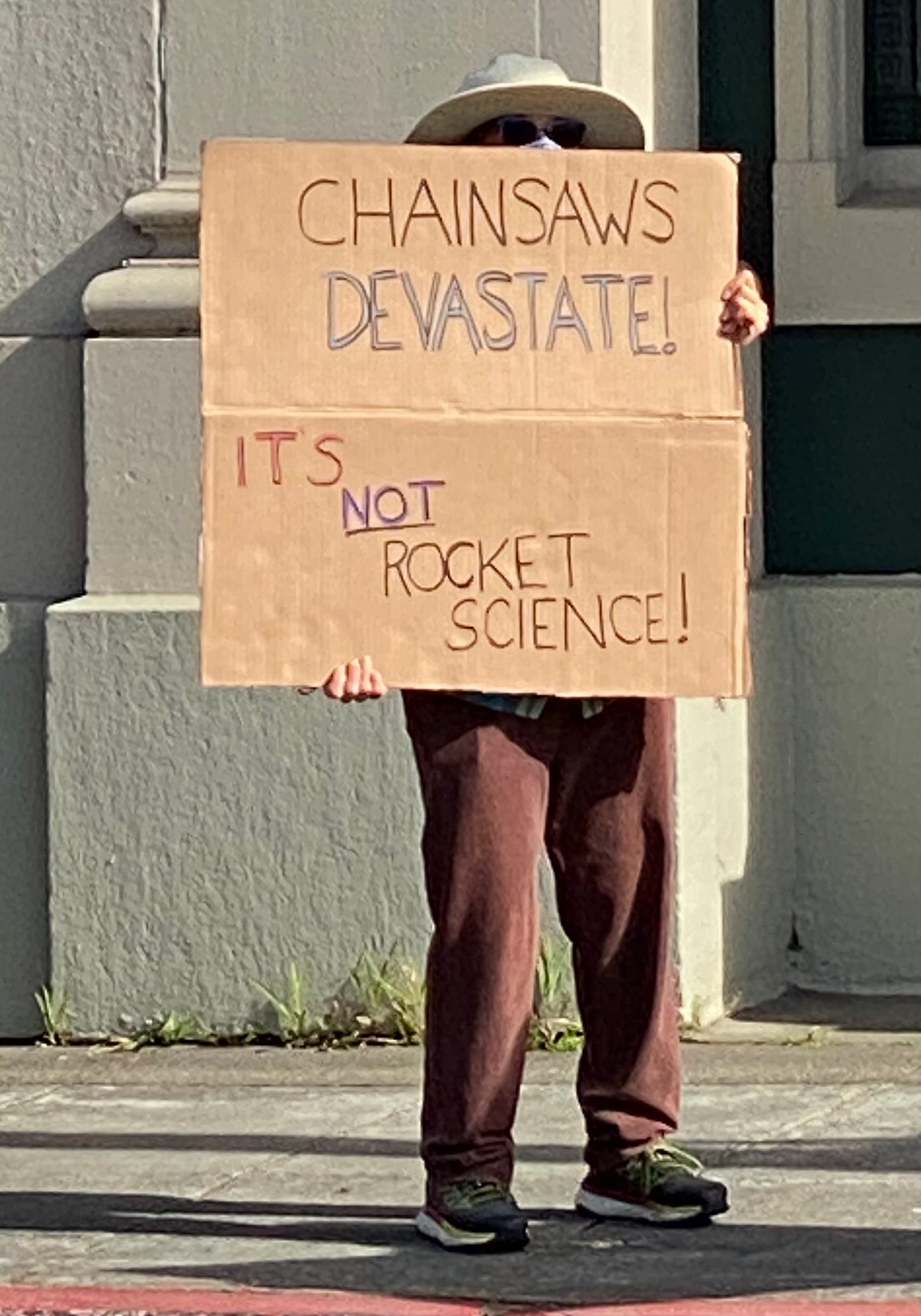(A sign from the protest in Sebastopol on April 19)
I meant to send this yesterday, but instead I cleaned the house. It really needed it. I will never be in the running for World’s Best Housekeeper, but when it gets to a certain level of dirt and mess, I just have to do something about it.
Which could also explain why I’m an activist, and why I got myself out to a protest on Saturday although my day was extremely complicated. Various events prevented me from making it to one of the larger marches or rallies, but I did manage to get to a demonstration that local folks had organized in the town of Sebastopol, just where I needed to be later in the evening. It was small, but mighty, with some very creative signs, lots of supportive honks, and even a visitation from the Easter Bunny!
And it’s a good example of the value of diversity. Today is Earth Day and I want to begin what I hope will be an intermittent series of short posts on permaculture principles and ethics, and how they might apply to the current political moment. I teach and write about permaculture, which is a system of ecological design that works with nature to meet human needs while regenerating the environment around us. While we generally think of ipermaculture in terms of farming, gardening, and land management, many of the principles work extremely well for social permaculture, the design of human systems, including activism.
Diversity is a case in point. In ecosystems, diversity generates resilience. In a living prairie you might have 400 different grasses, forbes, and legumes growing. Underground will be a thriving ecosystem of bacteria of various kinds, protists, fungi, microscopic worms, microarthropods, insects and worms. All of this will support a diversity of above-ground life, from birds to bison. And should a bug or a disease enter into the system that attacks a particular plant, it will have a hard time waiting through all of that diversity to find its next victim.
Compare that to a field of genetically engineered corn, grown in soil near-sterilized from herbicides and pesticides. Should a bug attack that corn, there will be nothing to stop it munching its way across the entire field. Even any potential variation in genetic resistance will have been engineered out.
Lack of diversity leaves us open to catastrophe. Later this summer, we’re planning a family vacation in Ireland where my husband’s great-grandparents came from, fleeing the potato famine of the 1840s. One reason why the famine was so devastating was that everyone grew the same susceptible variety of potato. (There were other reasons, mostly oppression, poverty, the unwillingness of landlords to allow their tenants to benefit from other more diverse sources of food. Ireland was actually exporting grain while people starved.)
Diversity in our human systems also generates resilience. If we have a group, an organization, or a classroom that includes a diversity of people from different backgrounds, races, religions, gender identities, economic classes, heritages, and life experiences, we have a much broader set of lenses through which to view the world. Our perspectives will be broadened and our ability to make decisions will be informed by a much wider base of information.
When we artificially limit diversity, when, for example, we say only male-born men should be scientists, we cut ourselves off from the intelligence and the imagination of half of humanity. Malcolm X was discouraged from becoming a lawyer because of his race. How much other intelligence, talent, and creativity has the world been deprived of because of various forms of discrimination?
Of course diversity has its constraints. We don’t plant a cactus in the middle of a redwood forest, because it couldn’t grow there. The conditions are all wrong. Nor should we plant kudzu in the midst of an Appalachian woods in the name of diversity—that vine will take over and destroy more than it benefits. Nor do we need to do outreach to die-hard MAGA supporters to join our Tesla Takedown group: that type of diversity will undermine our purpose. But we do need to consider how we can be open and welcoming to those who share our goals and our core values, even if they may look different, sound different, or take a different approach.
So know that when Trump and MAGA attack diversity, equity and inclusion programs, they are attacking your organization’s ultimate resilience, and making you stupider. If you’re fighting to keep those programs, know that you’re fighting for your future intelligence, creativity, and access to the broad range of perspectives we need to carry us through times of enormous challenges and change.
They want to make us into a sterile, boring, uniform monoculture. Instead, let us be a prairie, diverse, vibrant and resilient.
I keep my posts free for all to read—and if you subscribe, at any level, you’ll get them delivered to your inbox. If you can afford to upgrade to a paid subscription, you will help support my writing and organizing and earn my undying gratitude! Plus you’ll get the following benefits:
Paid Subscribers: $6 a month or $60 a year
· Full access to all posts and archives.
· Community Conversations: A monthly live discussion with Starhawk.
· Starhawk’s Tangled Web: A dedicated chat thread for paid subscribers
For WebWeavers: Founding members at $300 a year ($25 a month)
All of the above, plus:
· The Spider’s Thread: A dedicated chat thread for WebWeavers
Regardless of what level you choose, know that I am so grateful to have you part of this community!
This post has been syndicated from Starhawk’s Substack, where it was published under this address.


